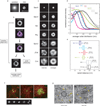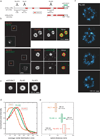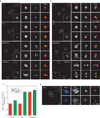Subdiffraction-resolution fluorescence microscopy reveals a domain of the centrosome critical for pericentriolar material organization
- PMID: 23086239
- PMCID: PMC3767400
- DOI: 10.1038/ncb2597
Subdiffraction-resolution fluorescence microscopy reveals a domain of the centrosome critical for pericentriolar material organization
Abstract
As the main microtubule-organizing centre in animal cells, the centrosome has a fundamental role in cell function. Surrounding the centrioles, the pericentriolar material (PCM) provides a dynamic platform for nucleating microtubules. Although the importance of the PCM is established, its amorphous electron-dense nature has made it refractory to structural investigation. By using SIM and STORM subdiffraction-resolution microscopies to visualize proteins critical for centrosome maturation, we demonstrate that the PCM is organized into two main structural domains: a layer juxtaposed to the centriole wall, and proteins extending farther away from the centriole organized in a matrix. Analysis of Pericentrin-like protein (PLP) reveals that its carboxy terminus is positioned at the centriole wall, it radiates outwards into the matrix and is organized in clusters having quasi-nine-fold symmetry. By RNA-mediated interference (RNAi), we show that PLP fibrils are required for interphase recruitment and proper mitotic assembly of the PCM matrix.
Figures







Comment in
-
Cell cycle: Order in the pericentriolar material.Nat Rev Mol Cell Biol. 2012 Dec;13(12):749. doi: 10.1038/nrm3471. Epub 2012 Oct 25. Nat Rev Mol Cell Biol. 2012. PMID: 23095798 No abstract available.
References
-
- Bettencourt-Dias M, Glover DM. Centrosome biogenesis and function: centrosomics brings new understanding. Nat Rev Mol Cell Biol. 2007;8(6):451–463. - PubMed
Publication types
MeSH terms
Substances
Grants and funding
LinkOut - more resources
Full Text Sources
Other Literature Sources
Research Materials

